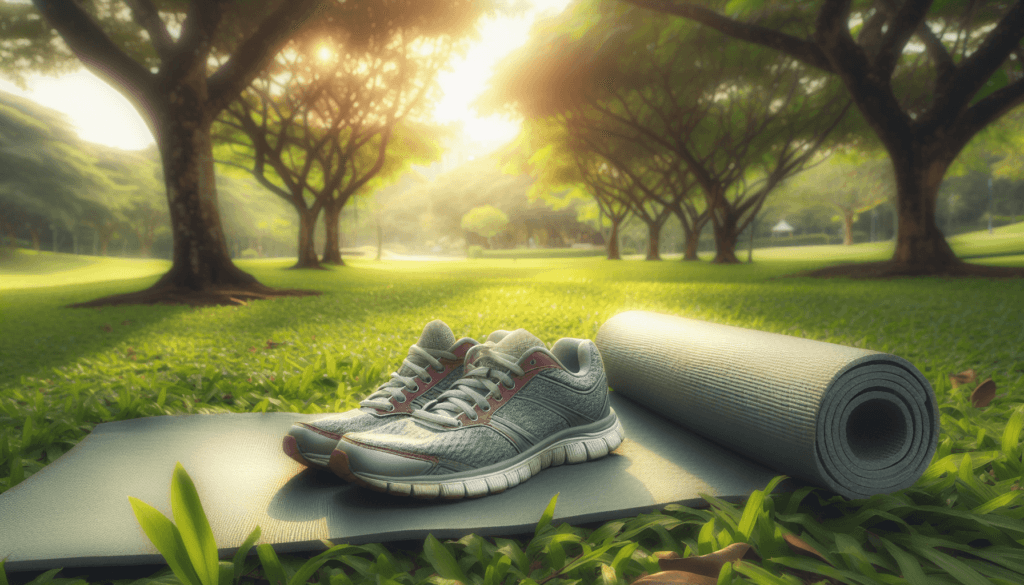Have you ever wondered how you can enhance your well-being through physical and mental health activities? This comprehensive guide aims to introduce you to various ways you can improve your overall health and well-being by focusing on physical and mental health activities.
Table of Contents
Overview
In today’s fast-paced world, it’s increasingly important to prioritize both your physical and mental health. Neglecting either can result in numerous health issues, both immediate and long-term. The relevance of this topic cannot be overstated, as a balanced approach to well-being can lead to a more fulfilling and healthier life.
Thesis Statement
In this article, you will discover a myriad of physical and mental health activities designed to enhance your well-being, supported by factual evidence and real-life examples. By integrating these practices into your daily routine, you can lead a happier, healthier life.
Rationale
Historical Context
Historically, physical and mental health were often treated as separate entities. Ancient civilizations such as the Greeks and Romans focused on physical health through activities like wrestling and running. Mental health, on the other hand, was clouded in superstition and often misunderstood. However, in recent years, a more holistic approach has emerged that emphasizes the interdependence of physical and mental health. This paradigm shift is critical in recognizing that a balanced approach can lead to a more well-rounded life.
Current Trends
In modern times, various trends have emerged in the realm of health and well-being. Activities like yoga, mindfulness meditation, and high-intensity interval training (HIIT) have become quite popular. These trends not only bolster physical strength but also contribute to mental resilience. Technology has also played a pivotal role, with numerous apps available to aid in fitness and mental health exercises. Specific examples include the Headspace app for mindfulness and the Nike Training Club app for physical workouts.

This image is property of pixabay.com.
Key Concepts and Definitions
Physical Health
Physical health refers to the overall condition of your body. It encompasses various aspects, including physical fitness, nutrition, and rest. Regular physical activity helps improve cardiovascular health, muscle strength, and overall endurance.
Mental Health
Mental health involves your emotional, psychological, and social well-being. It affects how you think, feel, and act. Mental health can be improved through activities that reduce stress, boost mood, and increase overall happiness.
Physical Health Activities
Cardiovascular Exercises
Cardiovascular exercises are designed to improve heart health. Activities such as running, cycling, and swimming increase your heart rate, promote blood circulation, and help in burning calories. According to the American Heart Association, adults should aim for at least 150 minutes of moderate-intensity cardiovascular exercise each week.
Strength Training
Strength training focuses on improving muscle strength and endurance. Exercises like weight lifting, resistance band workouts, and body-weight exercises (push-ups, squats) fall into this category. The CDC recommends adults engage in muscle-strengthening activities at least two days per week.
Flexibility Exercises
Flexibility is an often-overlooked aspect of physical health. Practices like yoga and Pilates not only enhance flexibility but also improve balance and posture. These exercises help reduce muscle tension and improve overall mobility.
Example 1: A Case Study on Team Sports
Participating in team sports offers multiple benefits. According to a study published in the Journal of Sports Medicine, individuals who participate in team sports report higher levels of life satisfaction and lower levels of stress. This is due to the dual benefits of physical exertion and social interaction.
Example 2: Personal Training Programs
Personal training programs can be highly effective for those looking to achieve specific health goals. A study by the American Council on Exercise found that individuals who followed a personalized exercise regimen under the guidance of a certified trainer achieved greater fitness gains compared to those who exercised on their own.

This image is property of pixabay.com.
Mental Health Activities
Mindfulness and Meditation
Mindfulness and meditation practices are essential for improving mental health. These techniques help cultivate an awareness of the present moment, which can significantly reduce stress and anxiety. Mindfulness-based stress reduction (MBSR) programs, for instance, have been shown to improve both mental and physical health outcomes.
Cognitive Behavioral Techniques (CBT)
Cognitive Behavioral Techniques are effective methods for dealing with negative thoughts and emotions. CBT involves identifying and challenging distorted thoughts and beliefs, thereby improving emotional regulation. According to the National Institute of Mental Health, CBT is one of the most effective treatments for anxiety and depression.
Creative Activities
Engaging in creative activities like painting, writing, or playing a musical instrument can significantly improve mental health. These activities offer an outlet for expression and can be therapeutic, reducing stress levels and improving overall mood.
Example 1: A Case Study on Art Therapy
Art therapy is a form of expressive therapy that uses the creative process to improve mental health. A study published in the Journal of the American Art Therapy Association found that participants who engaged in art therapy experienced a significant reduction in symptoms of anxiety and depression.
Example 2: The Benefits of Journaling
Journaling is an effective way to process emotions and thoughts. Research published in the Journal of Psychosomatic Medicine showed that expressive writing (writing about stressful or emotional experiences) resulted in significant health improvements, including better immune function.
Comparison of Different Approaches
Physical Activities vs. Mental Activities
| Aspect | Physical Activities | Mental Activities |
|---|---|---|
| Benefits | Improves cardiovascular health, muscle strength, and flexibility. | Reduces stress, improves mood, and enhances emotional regulation. |
| Immediate Effects | Increased energy levels, weight loss. | Immediate stress relief, sense of calm. |
| Long-term Benefits | Reduced risk of chronic diseases, improved longevity. | Improved mental resilience, better coping mechanisms. |
| Required Resources | May require equipment (e.g., weights, running shoes). | Often requires minimal resources (e.g., meditation app, pen and paper). |
| Examples | Running, weight lifting, yoga. | Mindfulness meditation, CBT, journaling. |
Integrated Approach
Combining physical and mental health activities offers a balanced approach to well-being. For example, practicing yoga not only improves flexibility and strength but also incorporates mindfulness and meditation practices. Similarly, outdoor activities like hiking can offer both physical exertion and mental relaxation.

This image is property of pixabay.com.
Impact Assessment
Physical Health Impacts
Engaging in regular physical health activities has a profound impact on overall well-being. According to the World Health Organization, physical inactivity is one of the leading risk factors for global mortality. By participating in regular physical activities, individuals can significantly reduce their risk of cardiovascular disease, diabetes, and certain cancers.
Mental Health Impacts
Mental health activities have been shown to significantly improve emotional and psychological well-being. The American Psychological Association states that interventions like CBT and mindfulness can lead to reduced symptoms of anxiety and depression, improved emotional regulation, and better quality of sleep.
Combined Impact
Combining physical and mental health activities creates a synergistic effect that amplifies overall well-being. For instance, regular physical exercise can enhance the effectiveness of mental health activities by improving mood and reducing symptoms of anxiety and depression.
Future Directions and Implications
Predictions
As the understanding of the connection between physical and mental health continues to evolve, future trends are likely to focus on integrated wellness programs. These programs will combine physical exercise with mental health practices such as mindfulness and stress management techniques. Technology will also play a crucial role, with advancements in health tracking devices and wellness apps providing personalized recommendations based on individual health metrics.
Implications
The implications of prioritizing both physical and mental health are far-reaching. In the workplace, integrated wellness programs can lead to increased productivity, reduced absenteeism, and lower healthcare costs. On a societal level, widespread adoption of these practices can result in a healthier population, reducing the burden on healthcare systems and improving overall quality of life.
Example of Future Scenarios
Imagine a world where every school incorporates a daily routine that consists of both physical exercise and mindfulness practices. Such an environment would not only promote physical health but also equip students with the tools for emotional resilience. This could lead to reduced levels of stress and anxiety among young people, fostering a generation that is both physically and mentally robust.

Conclusion
Summarize
In summary, the integration of physical and mental health activities is essential for enhancing overall well-being. Physical activities like cardiovascular exercises, strength training, and flexibility exercises offer numerous health benefits, from improving cardiovascular health to enhancing muscle strength. On the other hand, mental health activities such as mindfulness, CBT, and creative pursuits significantly reduce stress and improve mood. Combining these approaches creates a balanced and holistic pathway to better health.
Final Thoughts
Consider the various activities discussed in this article and how they can fit into your daily routine. Whether it’s starting with a morning run, practicing mindfulness before bed, or engaging in creative activities during your leisure time, incorporating these practices can lead to a more fulfilling and healthier life. What steps are you planning to take to enhance your well-being through physical and mental health activities?
By prioritizing both physical and mental health, you’ll not only improve your life but also set a positive example for those around you. Don’t underestimate the combined power of these activities to transform your well-being dramatically. For more detailed strategies on integrating these practices, look up relevant internal links to guide your journey towards better health.
Journey to Wellness: How Travel Can Enhance Your Health and Delay Aging

